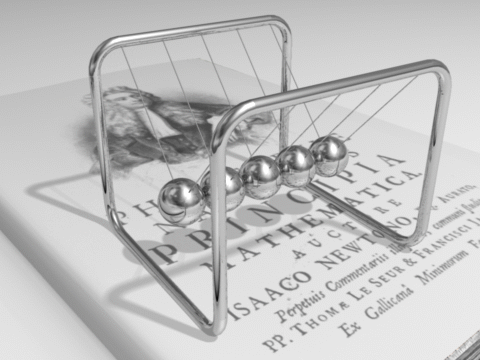Study Guide: Newton's Cradle

A Newton’s Cradle demonstrates the conservation of momentum and the conservation of energy using swinging spheres.
When we swing a marble on the end of the cradle, it collides with the marble next to it, and the force of that collision travels through each of the other marbles until it reaches the last one, which suddenly swings upward due to the force transferred to it. When the marble swings back due to the pull of gravity, the force of momentum travels back through each marble again, repeating the process.
The effect can be seen in sliding a coin on a table into a line of identical coins, as long as the striking coin and its twin targets are in a straight line. The effect can also be seen in billiard balls.
The device is named after 17th-century English scientist Isaac Newton and designed by French scientist Abbé Mariotte. The principle was first demonstrated by the French physicist Abbé Mariotte in the 17th century. His work on the topic was presented to the French Academy of Sciences in 1671; it was published in 1673 as Traité de la percussion ou choc des corps (“Treatise on percussion or shock of bodies”).
Newton acknowledged Mariotte’s work, along with Wren, Wallis and Huygens as the pioneers of experiments on the collisions of pendulum balls, in his Principia.
Conservation of Momentum
This also demonstrates the principle of Conservation of Momentum. This principle states that when two objects collide their momentum before the collision equals their momentum after the collision. In Newton’s Cradle the momentum force of the collision travels through each marble until it reaches the last one, which then swings up with the force of the momentum.
Mass and Density
Momentum is directly related to the density of an object. Density is a measure of the amount of mass per unit of volume. Denser objects have more mass. The more mass an object has, the stronger the force of momentum.
$$ Momentum = Mass \times Velocity $$Engineering and Tolerances
Newton’s Cradle also demonstrates the concept of tolerances. In engineering, products must be built very precisely or they may fail to work correctly or worse, fall apart. For example, see these early attempts at building flying machines…
This project uses a rigid frame. A frame is a structure that holds something tightly in place. The cradle has a lot of movement in the marbles and will not work if the frame moves. For a Newton’s Cradle to work well the following conditions must be met:
- The frame must be rigid and stable.
- The marbles must be made of a material with plenty of mass, such as metal or glass.
- The lengths and positions of the strings must be very accurate.
- The marbles must hang side-by-side in a perfectly straight line.
- The marbles must just touch each other with zero space between them.
Flying Failures (4:26)
How To Make Amazing Newton’s Cradle from Cardboard (5:33)
Sources
- https://en.wikipedia.org/wiki/Newton%27s_cradle
- https://www1.grc.nasa.gov/beginners-guide-to-aeronautics/newtons-laws-of-motion/
- https://en.wikipedia.org/wiki/Newton%27s_law_of_universal_gravitation


